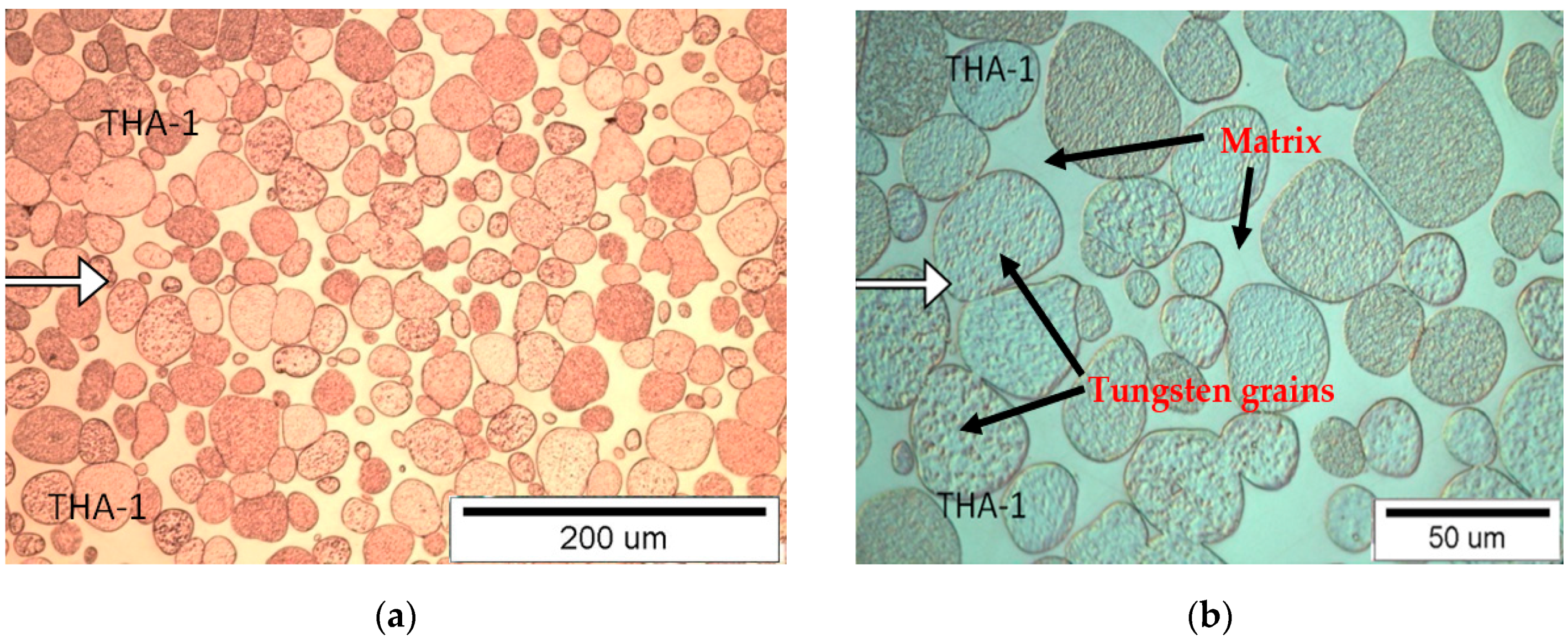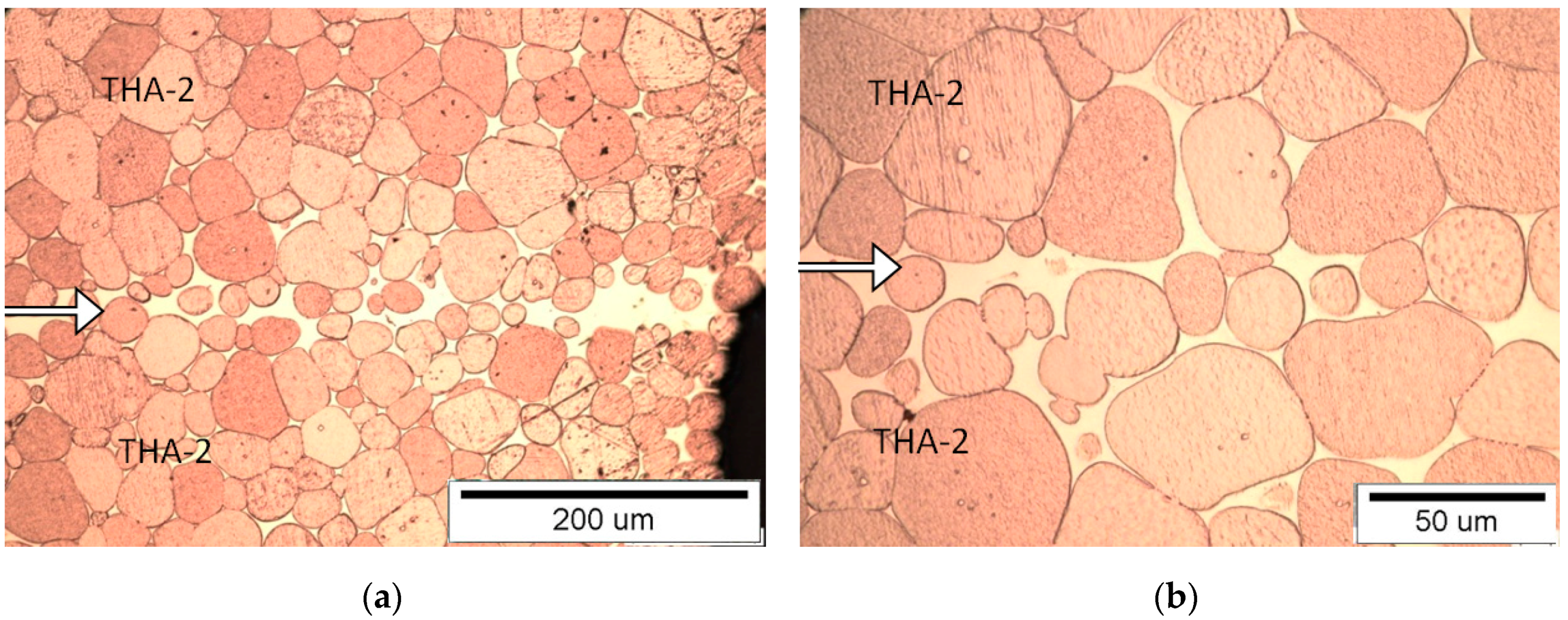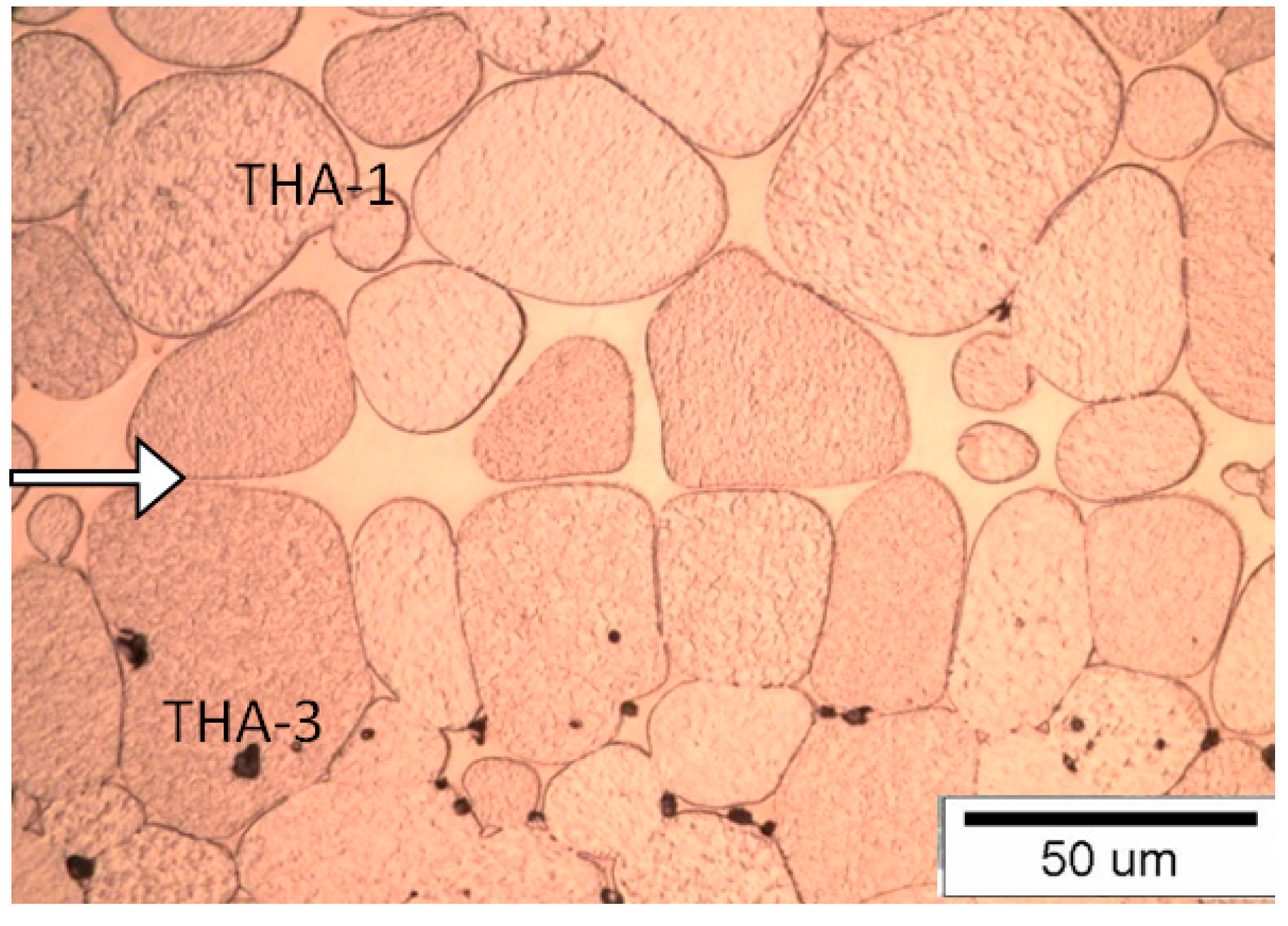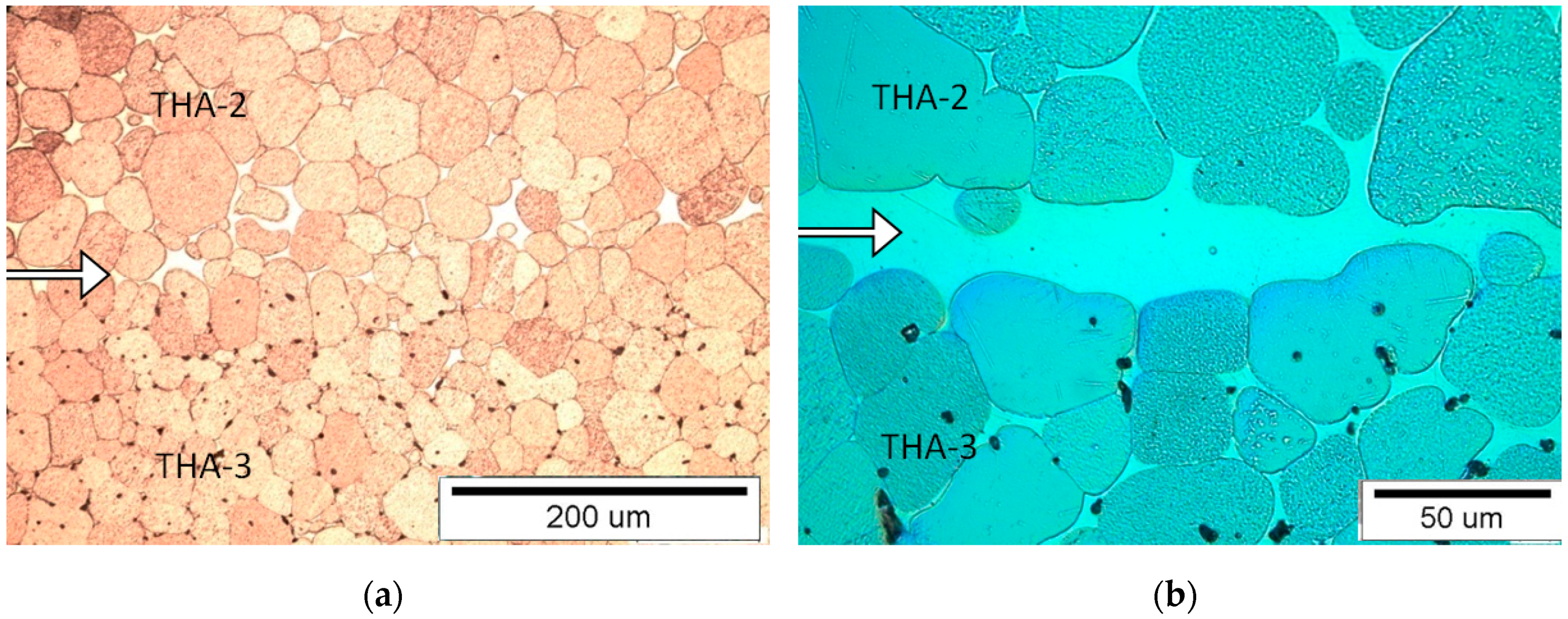Microstructure and Properties of Tungsten Heavy Alloy Connections Formed during Sintering with the Participation of the Liquid Phase
Abstract
1. Introduction
2. Materials and Methods
3. Results
3.1. Analysis of the Microstructure of Joints
3.1.1. Connection Type THA-1 with THA-1
3.1.2. Connection Type THA-2 with THA-2
3.1.3. Connection Type THA-3 with THA-3
3.1.4. Connection Type THA-1 with THA-3
3.1.5. Connection Type THA-1 with THA-2
3.1.6. Connection Type THA-2 with THA-3
3.2. Strength Tests
3.2.1. Static Tensile Test Testing
3.2.2. Impact Test Results
4. Discussion
5. Conclusions
- It is possible to bond the same and dissimilar materials under sintering conditions with the participation of the liquid phase.
- In homonymous materials, the microstructure in the joint area is homogeneous and does not differ in morphological features from the area further from the joint area, which makes location difficult to determine correctly.
- The strength of the combination of homonymous materials is comparable to the original material. The strength of joints in dissimilar materials is comparable to that of a tungsten heavy alloy material with lower strength used in the joined pair.
- In the case of materials with properly prepared front surfaces (no gaps), a joint is obtained without a layer of solidified matrix.
- Determining the location of the connection line in dissimilar materials is easier to determine due to the size of tungsten grains in both materials and the amount of matrix.
- The results obtained constitute the basis for the continuation of further work, including subjecting the obtained joints to plastic cold forging.
- The homogeneity of the microstructure and the lack of a visible boundary between the materials are the result of dissolution and crystallization processes taking place in the liquid phase.
Author Contributions
Funding
Conflicts of Interest
References
- German, R.M. Liquid Phase Sintering; Plenum Press: New York, NY, USA, 1985. [Google Scholar]
- Bose, A.; Sadangi, R.; German, R.M. A review on alloying in tungsten heavy alloys. Suppl. Proc. Mater. Process. Interfaces 2012, 1, 453–465. [Google Scholar]
- Das, J.; Ravi Kiran, U.; Chakraborty, A.; Eswara, N. Hardness and tensile properties of tungsten based heavy alloys prepared by liquid phase sintering technique. Int. J. Refract. Met. Hard Mater. 2009, 27, 577–583. [Google Scholar] [CrossRef]
- Kunčická, L.; Kocich, R.; Klečková, Z. Effects of sintering conditions on structures and properties of sintered tungsten heavy alloy. Materials 2020, 13, 2338. [Google Scholar] [CrossRef]
- German, R.M. Critical developments in tungsten heavy alloys. In Proceedings of the 1th International Conference on Tungsten and Tungsten Alloys, Arlington, VA, USA, 15–18 November 1992; pp. 3–13. [Google Scholar]
- Lassner, E.; Schubert, W.D. Tungsten: Properties, Chemistry, Technology of the Element, Alloys, and Chemical Compounds; Plenum Publishers: New York, NY, USA, 1999. [Google Scholar]
- Mclennan, J.C.; Smithells, C.J. A new alloy specially suitable for use in radium beam therapy. J. Sci. Instrum. 1935, 12, 159–160. [Google Scholar] [CrossRef]
- Massalski, T.B. Binary Alloy Phase Diagrams; ASM International: Russell Township, OH, USA, 1990. [Google Scholar]
- Yu, Y.; Wang, E.-D. Microstructure and properties of liquid phase sintered tungsten heavy alloys by using ultra-fine tungsten powders. Trans. Nonferrous Met. Soc. China 2004, 14, 912–917. [Google Scholar]
- Tan, X.-L.; Leng, B.-Y.; Qiu, S.-Y. Influences of sub-micrometer Ta and Co dopants on microstructure and properties of tungsten heavy alloys. Trans. Nonferrous Met. Soc. China 2004, 14, 747–750. [Google Scholar]
- Rabin, B.H.; Bose, A.; German, R.M. Characteristics of liquid phase sintered tungsten heavy alloys. Int. J. Powder Metall. 1989, 25, 21–27. [Google Scholar]
- Bose, A.; German, R.M. Sintering atmosphere effects on tensile properties of heavy alloys. Metall. Trans. A Phys. Metall. Mater. Sci. 1988, 19, 66–77. [Google Scholar] [CrossRef]
- Price, G.H.S.; Smithells, C.J.; Williams, S.V. Sintered alloys part IA, alloys sintered with a liquid phase present. J. Inst. Met. 1938, 62, 239–264. [Google Scholar]
- Magness, L.S.; Kapoor, D. Flow-softening tungsten composites for kinetic energy penetrator applications. In Proceedings of the 2nd International Conference on Tungsten and Refractory Metals, McLean, VA, USA, 17–19 October 1994. [Google Scholar]
- Lanz, W.; Odermatt, W.; Weihrauch, G. Kinetic energy projectiles: Development history, state of the art, trends. In Proceedings of the 19th International Symposium of Ballistics, Interlaken, Switzerland, 7–11 May 2001. [Google Scholar]
- Kumbhar, K.; Senthil, P.P.; Gogia, A.K. Microstructural observations on the terminal penetration of long rod projectile. Def. Technol. 2017, 13, 413–421. [Google Scholar] [CrossRef]
- Kennedy, C.; Murr, L.E. Comparison of tungsten heavy-alloy rod penetration into ductile and hard metal targets: Microstructural analysis and computer simulations. Mater. Sci. Eng. A 2002, 325, 131–143. [Google Scholar] [CrossRef]
- Kruszka, L.; Janiszewski, J.; Grązka, M. Experimental and numerical analysis of Al6063 duralumin using Taylor impact test. In EPJ Web of Conferences; EDP Sciences: Paris, France, 2012; Volume 26. [Google Scholar] [CrossRef]
- Yadav, S.; Ramesh, K.T. The dynamic behavior of a tungsten-hafnium composite for kinetic energy penetrator applications. In Proceedings of the 4th International Conference on Tungsten Refractory Metals and Alloys, Lake Buena Vista, FL, USA, 17–19 November 1997; pp. 111–117. [Google Scholar]
- Hauver, G.E.; Melani, A. Behavior of Segmented Rods During Penetration, Technical Report BRL-TR-3129; Ballistic Research Laboratory: Aberdeen Proving Ground, MD, USA, 1990. [Google Scholar]
- Arnold, W. Tungsten heavy alloys for multiple impact applications. AIP Conf. Proc. 2004, 706, 1319–1322. [Google Scholar]
- Das, J.; Rao, G.A.; Pabi, S.K. Deformation behavior of a newer tungsten heavy alloy. Mater. Sci. Eng. A 2011, 528, 6235–6247. [Google Scholar] [CrossRef]
- Skoczylas, P.; Goroch, O.; Gulbinowicz, Z.; Barcz, K.; Kaczorowski, M. Research into the production of tungsten heavy alloys with specific mechanical properties. Probl. Mechatron Armament Aviat. Saf. Eng. 2019, 10, 23–36. [Google Scholar] [CrossRef]
- Durlu, N.; Çalişkan, N.K.; Bor, Ş. Effect of swaging on microstructure and tensile properties of W–Ni–Fe alloys. Int. J. Refract. Met. Hard Mater. 2014, 42, 126–131. [Google Scholar] [CrossRef]
- Skoczylas, P.; Kaczorowski, M. The influence of cyclic sintering on the structure and mechanical properties of Tungsten Heavy Alloy. Arch. Foundry Eng. 2016, 16, 131–136. [Google Scholar] [CrossRef][Green Version]
- Hyung, B.W.; Hee, H.M.; Pyo, K.E. Heat treatment behavior of tungsten heavy alloy. Solid State Phenom. 2006, 118, 35–40. [Google Scholar]
- Kaczorowski, M.; Skoczylas, P.; Krzyńska, A.; Kaniewski, J. The strengthening of weight heavy alloys during heat treatment. Arch. Foundry Eng. 2012, 12, 75–80. [Google Scholar] [CrossRef]
- Katavić, B.; Odanović, Z.; Burzi, M. Investigation of the rotary swaging and heat treatment on the behavior of W- and γ- phase in PM 92,5W-%-Ni-2,5Fe-0,26Co heavy alloy. Mater. Sci. Eng. A 2008, 492, 337–345. [Google Scholar]
- Kaczorowski, M.; Skoczylas, P.; Krzyńska, A. The influence of Fe content on spreading ability of tungsten heavy alloys matrix on tungsten surface. Arch. Foundry Eng. 2011, 11, 103–106. [Google Scholar]
- Katavić, B.; Nikaćević, M.; Odanović, Z. Effect of cold swaging and heat treatment on properties of the P/M 91W-6Ni-3Co heavy alloy. Sci. Sinter. 2008, 40, 319–331. [Google Scholar] [CrossRef]
- Sunwoo, A.; Groves, S.; Goto, D. Effect of matrix alloy and cold swaging on micro-tensile properties of tungsten heavy alloys. Mater. Lett. 2006, 60, 321–325. [Google Scholar] [CrossRef]
- Kunčická, L.; Kocich, R.; Hervoches, C.; Macháčková, A. A study of structure and residual stresses in cold rotary swaged tungsten heavy alloy. Mater. Sci. Eng. A 2017, 704, 25–31. [Google Scholar] [CrossRef]
- Winiczenko, R.; Goroch, O.; Krzyńska, A.; Kaczorowski, M. Friction welding of tungsten heavy alloy with aluminium alloy. J. Mater. Process. Technol. 2017, 246, 42–55. [Google Scholar] [CrossRef]
- Kaczorowski, M.; Goroch, O.; Krzyńska, A. The mechanism of solid state joining THA with AlMg3Mn alloy. Arch. Foundry Eng. 2014, 14, 37–42. [Google Scholar] [CrossRef]
- Goroch, O.; Gulbinowicz, Z. Rotary friction welding of weight heavy alloy with wrought AlMg3 alloy for subcaliber ammunition. Adv. Sci. Technol. Res. J. 2017, 11, 1–15. [Google Scholar] [CrossRef][Green Version]
- Park, Z.S.; Woo, Y.Y.; Han, S.W.; Oh, I.Y.; Hwang, T.W.; Kim, Y.; Moon, Y.H. System development for diffusion bonding of multiple unit tubes to produce long tubular tungsten heavy alloys. Appl. Sci. 2020, 10, 2988. [Google Scholar] [CrossRef]
- Lu, Y.; Qiu, X.; Ruan, Y.; Luo, F.; Xing, F. Effect of Ti on microstructure and properties of tungsten heavy alloy joint brazed by CuAgTi C filler metal. Materials 2019, 12, 1057. [Google Scholar] [CrossRef]
- DIN 50115. Testing of Metallic Materials, Notched Bart Impact Test; DIN: Berlin, Germany, 1991. [Google Scholar]
- Standarization Agreement, STANAG 4190. Test Procedures for Measuring Behind-Armour Effects Anti-Armour Ammunition; NATO: Brussels, Belgium, 5 November 1998. [Google Scholar]










| THA-1 | THA-2 | THA-3 | |
|---|---|---|---|
| Density (g/cm3) | 17.40 | 18.44 | 18.53 |
| W (%) | 90.8 | 96.2 | 98.2 |
| Ni (%) | 6.2 | 2.8 | 1.4 |
| Fe (%) | 1.2 | 0.8 | 0.4 |
| Co (%) | 1.8 | 0.2 | 0 |
| THA-1 | THA-2 | THA-3 | |
|---|---|---|---|
| Ra (µm) | 0.30 0.28 0.28 | 0.32 0.31 0.32 | 0.34 0.34 0.34 |
| Rz (µm) | 2.42 2.20 2.36 | 2.51 2.49 2.47 | 2.95 2.67 2.95 |
| * Wa (µm) | 0.28 0.27 0.27 | 0.32 0.30 0.32 | 0.33 0.34 0.57 |
| A Sample | Rm (MPa) | Rp0.2 (MPa) |
|---|---|---|
| THA-1/THA-1 | 980 ± 9 | 645 ± 7 |
| THA-2/THA-2 | 945 ± 8 | 681 ± 6 |
| THA-3/THA-3 | 655 ± 20 | 580 ± 8 |
| THA-1/THA-2 | 942 ± 10 | 650 ± 8 |
| THA-1/THA-3 | 675 ± 13 | 569 ± 11 |
| THA-2/THA-3 | 670 ± 15 | 554 ± 12 |
| THA-1 | 990 ± 6 | 647 ± 9 |
| THA-2 | 944 ± 6 | 688 ± 9 |
| THA-3 | 680 ± 15 | 585 ± 10 |
| Sample No. | Types of Combined Materials | Impact Strength (J/cm2) | Place of Impact | the Place of the Crack |
|---|---|---|---|---|
| 1 | THA-1 with THA-1 | >150 | 5 mm from the joint | It was not broken |
| 2 | THA-1 with THA-1 | >300 | joint | It was not broken |
| 3 | THA-1 with THA-1 | 190 | joint | Next to the point of impact |
| 4 | THA-2 * | 33 | - | At the point of impact |
| 5 | THA-2 * | 36 | - | At the point of impact |
| 6 | THA-1 with THA-2 | 56 | connector | At the point of impact |
| 7 | THA-1 with THA-2 | 76 | 5 mm from the joint on the THA-2 side | At the point of impact |
| 8 | THA-1 with THA-2 | 150 | 5 mm from the joint on the THA-1 side | At the point of impact |
| 9 | THA-2 with THA-2 | 15 | joint | At the point of impact |
| 10 | THA-2 with THA-2 | 32 | 5 mm from the joint | At the point of impact |
Publisher’s Note: MDPI stays neutral with regard to jurisdictional claims in published maps and institutional affiliations. |
© 2020 by the authors. Licensee MDPI, Basel, Switzerland. This article is an open access article distributed under the terms and conditions of the Creative Commons Attribution (CC BY) license (http://creativecommons.org/licenses/by/4.0/).
Share and Cite
Skoczylas, P.; Gulbinowicz, Z.; Goroch, O. Microstructure and Properties of Tungsten Heavy Alloy Connections Formed during Sintering with the Participation of the Liquid Phase. Materials 2020, 13, 4965. https://doi.org/10.3390/ma13214965
Skoczylas P, Gulbinowicz Z, Goroch O. Microstructure and Properties of Tungsten Heavy Alloy Connections Formed during Sintering with the Participation of the Liquid Phase. Materials. 2020; 13(21):4965. https://doi.org/10.3390/ma13214965
Chicago/Turabian StyleSkoczylas, Paweł, Zbigniew Gulbinowicz, and Olgierd Goroch. 2020. "Microstructure and Properties of Tungsten Heavy Alloy Connections Formed during Sintering with the Participation of the Liquid Phase" Materials 13, no. 21: 4965. https://doi.org/10.3390/ma13214965
APA StyleSkoczylas, P., Gulbinowicz, Z., & Goroch, O. (2020). Microstructure and Properties of Tungsten Heavy Alloy Connections Formed during Sintering with the Participation of the Liquid Phase. Materials, 13(21), 4965. https://doi.org/10.3390/ma13214965





